#jsdf
Text
Why is it the War Devil?
Obviously, I am fascinated by the concept of the War Devil. There is a way in which her presence in the story is uniquely Japanese. Since WWII, the question of how to process the Empire’s defeat has hung over Japanese society. On the conservative side, there is a long project to minimize the realities of the War, especially atrocities committed by the Japanese Imperial Army. Alongside this, there is the concerted effort within the legislature to repeal Article 9 of the constitution, the article which forbids the Japanese government from raising an army. On the left, there is a desire for genuine reconciliation and strong support for article 9. However, the effort has not gained much of a foothold. Japan is, much like the United States, a strongly conservative country.

For example, when the historian Ienaga Saburo wrote his textbook “New Japanese History” for public schools in 1953, the government initially approved his manuscript, but when he resubmitted a revised version two years later, they demanded that 216 revisions be made. Revisions included minimizing the Rape of Nanking, adding a mention of public support for the Russo-Japanese war, etc. Straightforward government censorship of established historical fact.
Ienaga sued the government for damages arguing that he was protected by Article 21, the right to free speech. Note: his book was not a state standard. It was simply one of many textbooks available for use by schools. A district court ruled that the government’s demands didn’t constitute censorship, but did constitute an abuse of authority and granted monetary settlement. An appeal to the High court rejected the monetary settlement, and the Supreme Court upheld the appeal.
In other words, the Japanese Government was granted the right to dictate the facts of history “for the public good” in the words of the rulings. Realities of war were erased from the public consciousness with the intent to control the narrative around the Fallen Empire. And the state reasoning was a paternalistic appeal to the greater good of humanity. If this reminds you of Makima’s plan in part one, I am sure that is not a coincidence.
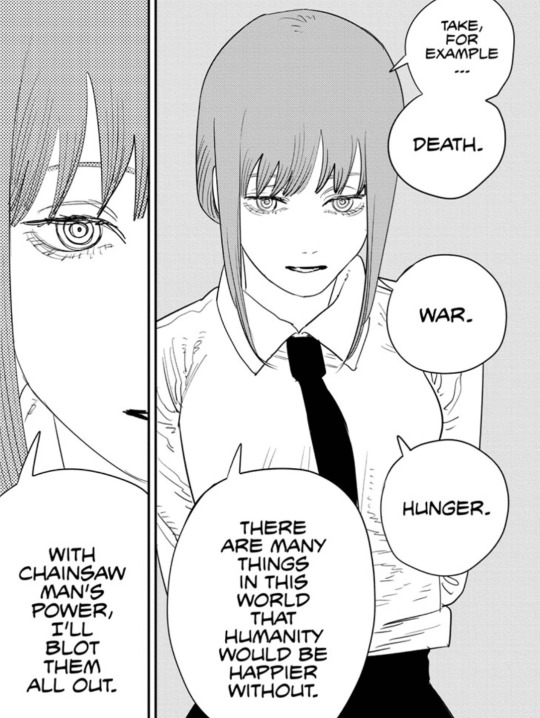
This is a metaphor that I think was broadly missed by the international audience. The idea that War should be forgotten for the sake of humanity, this is the ideology behind historical revisionism. Fujimoto is looking directly at the way that political power in Japan is used to manipulate public understanding of history. Pieces of the past are erased, eaten, and forgotten.
This is why I don’t lend much credence to the idea that Chainsaw Man actually modifies the fabric of the universe somehow when he eats a devil. It is not that the world changes, it is that people forget about it. It’s not that our forgotten sixth sense was deleted. We just forgot it used to exist. It disappeared, perhaps as a part of Chainsaw Man’s attack. And then we forgot.

The main reason I think of it this way is because of the parallel with historical revisionism. Right now in Florida the state government is attempting to erase the suffering of African slaves brought to America from the school curriculum. If they maintain this for three generations, no one in the state of Florida will know of this true part of history. It will be forgotten. Humanity in Florida will have forgotten a part of slavery. We don’t need supernatural mechanics to explain historical ignorance. This happens all the time.
Yoru describes this phenomenon in more detail: “War became a thing of books and movies.” Yoru became weakened as humanity became less afraid of war. Parts of the war that really happened are not gone, but have been consigned to unreality. They exist only at a distance. It is only one step further along this axis until they are completely forgotten, until they aren’t thought about at all.

This idea of forgetting War is directly relevant to the political conflicts around Article 9. This conflict is split as I mentioned, but the reality of the situation is more complex. During the occupation, the US Government directed the drafting of the new Japanese constitution. In a real sense, Japan was literally Americanized. The text of Article 9 reads:
Aspiring sincerely to an international peace based on justice and order, the Japanese people forever renounce war as a sovereign right of the nation and the threat or use of force as means of settling international disputes.
In order to accomplish the aim of the preceding paragraph, land, sea, and air forces, as well as other war potential, will never be maintained. The right of belligerency of the state will not be recognized.
This is part of Chapter 2 in the Articles of the Japanese Constitution. Other chapters contain multiple articles. This is the only article in chapter 2 which is titled “Renunciation of War.” To date, Japan is the only country in the world to include a renunciation of war in its constitution.
Of course, Article 9 doesn’t exist out of the kindness of the Japanese people’s peace loving hearts. It exists because the US military thought that the Japanese people were so intrinsically bloodthirsty, that if they didn’t dismantle the empire and remove their ability to raise an army, there could never be peace.
That said, Japanese politicians were involved in the drafting of the constitution as well. Since the war began in China in 1928, a significant faction even among the hawkish types were exasperated with the boneheaded aggression. But the fascists had control of the Emperor, the key figurehead. Once that was lost, cooler heads who were open to the idea of a peaceful Japan stepped in.
So Article 9 starts with this complex identity. On the one hand, it is an imposition by the occupying force, on the other hand, it is a reconciliation within Japan around mistakes the nation made. This remains the case going forward. Because soon after the occupation ends, the Korean War begins.
America, having secured a foothold in the region, realizes that militarily neutering their nearest ally may have been a tactical mistake. But they also still don’t really trust the Japanese government. So they make a move. The US signs a controversial security-treaty with Japan that creates the “National Security Force” to act as a military police. Japanese conservatives then use this precedent to begin building a military under the premise of it being for “self defense.” Thus the JSDF, Japanese Self Defense Force, is born. This was all done with explicit American support.
The American’s didn’t want to team up with the JSDF per se. They wanted Japan to manufacture weapons to create a short supply line towards the Korean front. The creation of the JSDF gives the Japanese government permission to permit manufacturing of military machinery, which was originally taken to be forbidden by Article 9.
Since it’s founding, the JSDF has gradually crept further and further towards active military activity. The final line was crossed in the Iraq war. At the behest of George W. Bush, Prime Minister Koizumi approved a battalion of Japanese soldiers to act in conjunction with the US military for the invasion of Iraq.
This occurs in 2004, in the wake of the 90s. Japan re-enters war in a real way. At this point, article 9 is essentially window dressing on a country which has what amounts to a fully functional military force. But, the existence of article 9 creates a public perception of Japan as being removed from war, even as it actively participates.
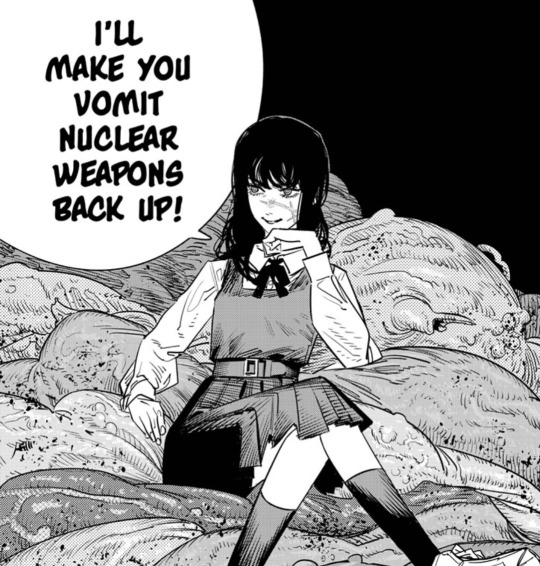
You can see now why when Yoru appeared in chapter 98 I was immediately excited. The idea of the War Devil coming back is a stab at the powers that be trying to paper over their militaristic intentions with political rhetoric. Conservatives are currently moving to repeal article 9. This was one of Shinzo Abe’s major objectives. But he failed to achieve it.
So the struggle continues under the current leadership. And in that context, Fujimoto is placing War front and center. War that has been forgotten but will come back. War that, should she return to full power, will turn legions of young men into weapons.
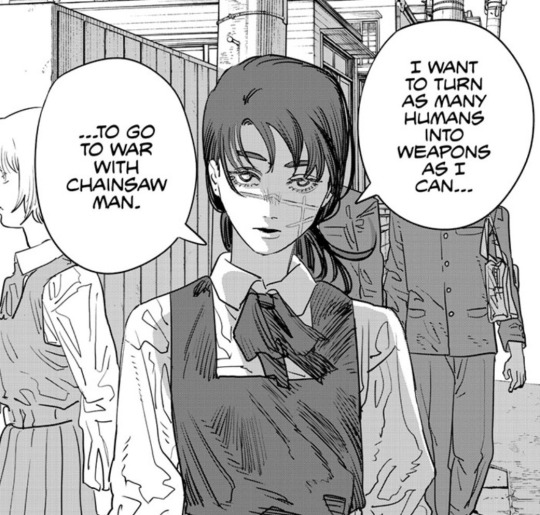
It’s a subtle but also daring message. The debate plays out in politics but is notably absent from public discourse. Japan is different from American in that political conflict doesn’t dominate its media landscape. Generally speaking, the media is running cover for the government.
So to see someone go after this idea of forgotten war, of war coming back from a weakened state, and to highlight the latent threat it poses, is quite refreshing. Once again, Fujimoto manages to subtly weave a cogent political message into the threads of his story, not necessarily by trying to push a particular narrative, but simply by reflecting in his work the political realities he sees in his society.
#chainsaw man analysis#japanese politics#Yoru#war devil#chainsaw man#manga analysis#ienaga saburou#war#Japanese self defense force#jsdf
160 notes
·
View notes
Text
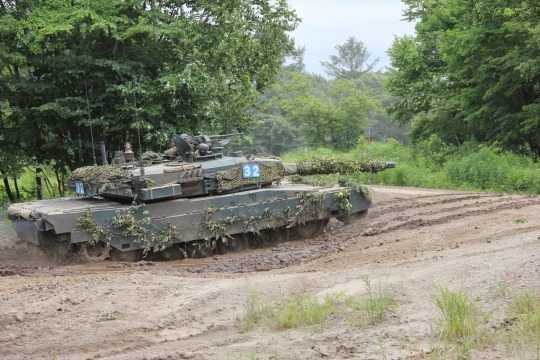
A Type 90 from the 72nd Tank Regiment, 7th Division, during a training exercise at Camp Kita-Eniwa, August 9th, 2013.
18 notes
·
View notes
Text

type 87
flakpanzer mein geliebter
#jazz-dude#art stuff#my art#illustration#artwork#tank#anti air#jsdf#type 87#vehicle#military vehicle#military
6 notes
·
View notes
Photo

Ex. Iron Fist // Japanese Ground Self-Defense Forces
#Japanese Ground Self-Defense Forces#JGSDF#Exercise Iron Fist#Ex. Iron Fist#Iron Fist#Iron Fist 23#Iron Fist 2023#Japan#1st Regimental Landing Team#1RLT#JSDF#Japan Maritime Self-Defense Force#JMSDF#USMC#USN#gunblr#milblr#military#armed forces#Force Design 2030#Howa#Howa Type-20#Type-20#rifle#carbine
12 notes
·
View notes
Text

2 notes
·
View notes
Text

Nothing to see here. Just a submarine sitting by the side of the road.
3 notes
·
View notes
Photo
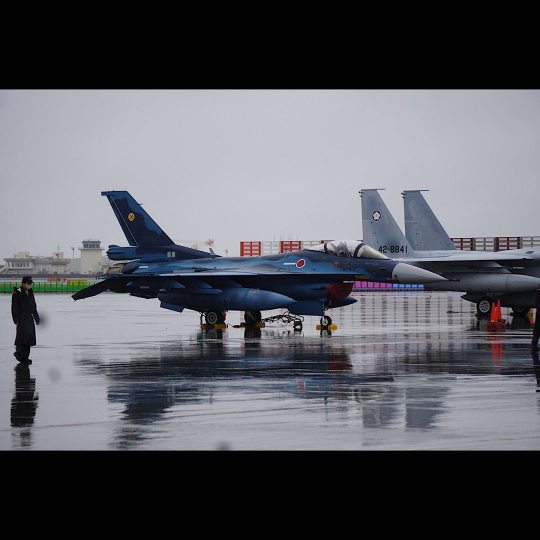
A Japanese Mitsubishi F-2 fighter at MCAS Iwakuni. Recently, the JSDF, US Marine Corps, and USAF hosted a special Friendship Day, which is a cultural event offering airshows, tours of vehicles, fun activities, and great food! I enjoyed getting a close look at some of the latest and greatest military aircraft. The F-2 pictured is a unique Japanese take on the General Dynamics F-16 Fighting Falcon with an even larger airframe and the iconic teal-blue paint. - - - - - #自衛隊 #mitsubishi #三菱重工 #mitsubishif2 #jsdf #岩国市 #iwakuni #mcasiwakuni #山口県岩国市 #fighterjet #sonyalpha #fukuoka_camera #travelphotography #seattlephotographer #usmarinecorps (at MCAS Iwakuni, Yamaguchi, Japan) https://www.instagram.com/p/CrcwngTPFdz/?igshid=NGJjMDIxMWI=
#自衛隊#mitsubishi#三菱重工#mitsubishif2#jsdf#岩国市#iwakuni#mcasiwakuni#山口県岩国市#fighterjet#sonyalpha#fukuoka_camera#travelphotography#seattlephotographer#usmarinecorps
4 notes
·
View notes
Text
Rory Mercury - GATE

2 notes
·
View notes
Text

Lelei La Lalena
#lelei#la lalena#mage#JSDF#japan self-defense forces#gate: jietai kanochi nite kaku tatakaeri#ate: thus the JSDF fought there#vector#minimalist#minimalistic#finished
8 notes
·
View notes
Photo

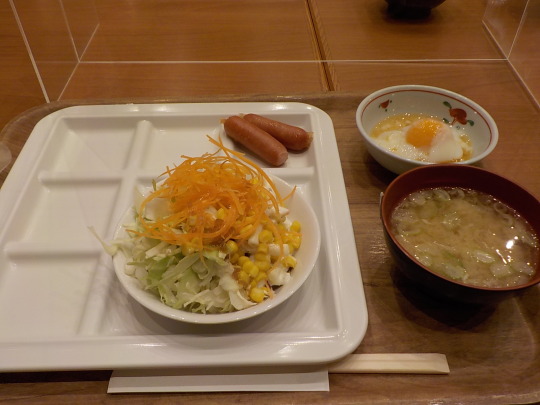







youtube
youtube
2022年7月31日、シャムロックカントリークラブでゴルフ。3つパーを取る。途中、千歳の航空祭で披露されたブルーインパルスのアクロバット飛行を楽しむ。
74 notes
·
View notes
Text
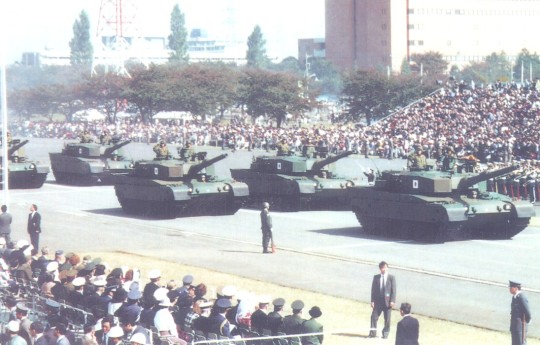
Type 90s on parade in Tokyo, October 31st, 1993.
The Type 90 is Japan's third tank produced after World War II. Due to concerns about the T-72, the Japanese Self Defense Forces' (JSDF) High Command sought a new design to supplement its current main battle tank (MBT) at the time, the Type 74. Work on the new vehicle, named TK-X, was carried out by Mitsubishi Heavy Industries and the Japanese Technology Research and Development Institute. It uses a 120mm smoothbore gun, and is equipped with a 1,500 hp diesel engine. The gun is autoloaded, meaning reloading the main gun is done by a machine, and can be done in as little as a few seconds, impressive given the size of the shells!
4 notes
·
View notes
Photo


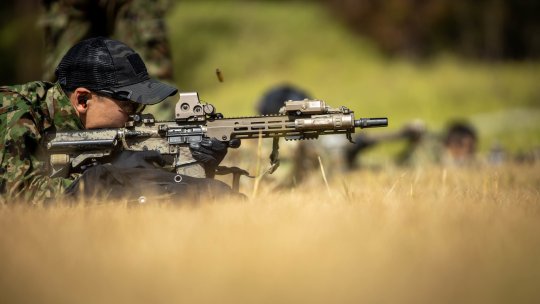

RIMPAC 2022 // Japan Maritime Self-Defense Force
#Japanese Maritime Self-Defense Forces#Japanese Self-Defense Forces#Japan#JMSDF#JSDF#RIMPAC#RIMPAC 2022#joint training exercise#Special Operations Forces#Special Forces#SOF#Military#Armed Forces#Milblr#Gunblr#H&K#HK416
32 notes
·
View notes
Text
youtube
#youtube#militarytraining#MarineCorps#JGSDF#ReconTraining#IronFist24#MilitaryTraining#SpecialForces#USMC#JapanSelfDefenseForces#JointExercise#CombatTraining#WarGames#TacticalTraining#MilitaryAlliance#InternationalPartnership#Defense#Marines#JSDF#MilitaryDrill#Reconnaissance#MilitaryExercise
0 notes